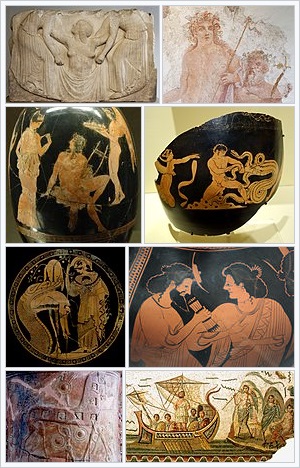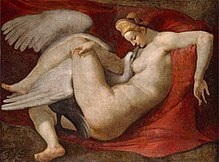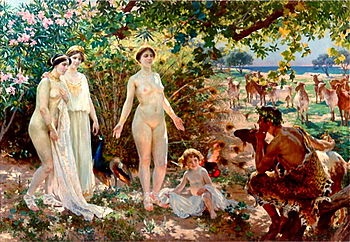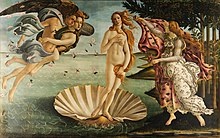|
|
| |
|
|
| |
|
|
|
|
| |
 |
| Scenes from Greek
mythology depicted in ancient art.
Left-to-right, top-to-bottom: the birth of
Aphrodite, a revel with Dionysus and Silenus,
Adonis playing the kithara for Aphrodite,
Heracles slaying the Lernaean Hydra, the
Colchian dragon regurgitating Jason in the
presence of Athena, Hermes with his mother Maia,
the Trojan Horse, and Odysseus's ship sailing
past the island of the sirens. |
Greek
Mythology
Greek mythology is the body of myths originally told by
the ancient Greeks, and a genre of Ancient Greek
folklore. These stories concern the origin and nature of
the world, the lives and activities of deities, heroes,
and mythological creatures, and the origins and
significance of the ancient Greeks' own cult and ritual
practices. Modern scholars study the myths to shed light
on the religious and political institutions of ancient
Greece, and to better understand the nature of
myth-making itself.
The Greek myths were initially propagated in an
oral-poetic tradition most likely by Minoan and
Mycenaean singers starting in the 18th century BC;
eventually the myths of the heroes of the Trojan War and
its aftermath became part of the oral tradition of
Homer's epic poems, the Iliad and the Odyssey. Two poems
by Homer's near contemporary Hesiod, the Theogony and
the Works and Days, contain accounts of the genesis of
the world, the succession of divine rulers, the
succession of human ages, the origin of human woes, and
the origin of sacrificial practices. Myths are also
preserved in the Homeric Hymns, in fragments of epic
poems of the Epic Cycle, in lyric poems, in the works of
the tragedians and comedians of the fifth century BC, in
writings of scholars and poets of the Hellenistic Age,
and in texts from the time of the Roman Empire by
writers such as Plutarch and Pausanias. |
|
 |
| Zeus, disguised as a
swan, seduces Leda, the Queen of Sparta. A
sixteenth-century copy of the lost original by
Michelangelo. |
Origins of the
world and the gods
"Myths of origin" or "creation myths" represent an
attempt to explain the beginnings of the universe in
human language. The most widely accepted version at the
time, although a philosophical account of the beginning
of things, is reported by Hesiod, in his Theogony. He
begins with Chaos, a yawning nothingness. Out of the
void emerged Gaia (the Earth) and some other primary
divine beings: Eros (Love), the Abyss (the Tartarus),
and the Erebus. Without male assistance, Gaia gave birth
to Uranus (the Sky) who then fertilized her. From that
union were born first the Titans—six males: Coeus, Crius,
Cronus, Hyperion, Iapetus, and Oceanus; and six females:
Mnemosyne, Phoebe, Rhea, Theia, Themis, and Tethys.
After Cronus was born, Gaia and Uranus decreed no more
Titans were to be born. They were followed by the
one-eyed Cyclopes and the Hecatonchires or
Hundred-Handed Ones, who were both thrown into Tartarus
by Uranus. This made Gaia furious. Cronus ("the wily,
youngest and most terrible of Gaia's children"), was
convinced by Gaia to castrate his father. He did this
and became the ruler of the Titans with his sister-wife,
Rhea, as his consort, and the other Titans became his
court.
A motif of father-against-son conflict was repeated when
Cronus was confronted by his son, Zeus. Because Cronus
had betrayed his father, he feared that his offspring
would do the same, and so each time Rhea gave birth, he
snatched up the child and ate it. Rhea hated this and
tricked him by hiding Zeus and wrapping a stone in a
baby's blanket, which Cronus ate. When Zeus was
full-grown, he fed Cronus a drugged drink which caused
him to vomit, throwing up Rhea's other children,
including Poseidon, Hades, Hestia, Demeter, and Hera,
and the stone, which had been sitting in Cronus's
stomach all this time. Zeus then challenged Cronus to
war for the kingship of the gods. At last, with the help
of the Cyclopes (whom Zeus freed from Tartarus), Zeus
and his siblings were victorious, while Cronus and the
Titans were hurled down to imprisonment in Tartarus.
Zeus was plagued by the same concern, and after a
prophecy that the offspring of his first wife, Metis,
would give birth to a god "greater than he", Zeus
swallowed her. She was already pregnant with Athena,
however, and she burst forth from his head—fully-grown
and dressed for war. |
|
 |
| El Juicio de Paris
by Enrique Simonet, 1904. Paris is holding the
golden apple on his right hand while surveying
the goddesses in a calculative manner. |
Greek pantheon
According to Classical-era mythology, after the
overthrow of the Titans, the new pantheon of gods and
goddesses was confirmed. Among the principal Greek gods
were the Olympians, residing on Mount Olympus under the
eye of Zeus. (The limitation of their number to twelve
seems to have been a comparatively modern idea.) Besides
the Olympians, the Greeks worshipped various gods of the
countryside, the satyr-god Pan, Nymphs (spirits of
rivers), Naiads (who dwelled in springs), Dryads (who
were spirits of the trees), Nereids (who inhabited the
sea), river gods, Satyrs, and others. In addition, there
were the dark powers of the underworld, such as the
Erinyes (or Furies), said to pursue those guilty of
crimes against blood-relatives. In order to honor the
Ancient Greek pantheon, poets composed the Homeric Hymns
(a group of thirty-three songs). Gregory Nagy (1992)
regards "the larger Homeric Hymns as simple preludes
(compared with Theogony), each of which invokes one
god."
The gods of Greek mythology are described as having
essentially corporeal but ideal bodies. According to
Walter Burkert, the defining characteristic of Greek
anthropomorphism is that "the Greek gods are persons,
not abstractions, ideas or concepts." Regardless of
their underlying forms, the Ancient Greek gods have many
fantastic abilities; most significantly, the gods are
not affected by disease, and can be wounded only under
highly unusual circumstances. The Greeks considered
immortality as the distinctive characteristic of their
gods; this immortality, as well as unfading youth, was
insured by the constant use of nectar and ambrosia, by
which the divine blood was renewed in their veins.
Each god descends from his or her own genealogy, pursues
differing interests, has a certain area of expertise,
and is governed by a unique personality; however, these
descriptions arise from a multiplicity of archaic local
variants, which do not always agree with one another.
When these gods are called upon in poetry, prayer, or
cult, they are referred to by a combination of their
name and epithets, that identify them by these
distinctions from other manifestations of themselves
(e.g., Apollo Musagetes is "Apollo, [as] leader of the
Muses"). Alternatively, the epithet may identify a
particular and localized aspect of the god, sometimes
thought to be already ancient during the classical epoch
of Greece.
Most gods were associated with specific aspects of life.
For example, Aphrodite was the goddess of love and
beauty, Ares was the god of war, Hades the ruler of the
underworld, and Athena the goddess of wisdom and
courage. Some gods, such as Apollo and Dionysus,
revealed complex personalities and mixtures of
functions, while others, such as Hestia (literally
"hearth") and Helios (literally "sun"), were little more
than personifications. The most impressive temples
tended to be dedicated to a limited number of gods, who
were the focus of large pan-Hellenic cults. It was,
however, common for individual regions and villages to
devote their own cults to minor gods. Many cities also
honored the more well-known gods with unusual local
rites and associated strange myths with them that were
unknown elsewhere. During the heroic age, the cult of
heroes (or demigods) supplemented that of the gods. |
|
 |
| Botticelli's The
Birth of Venus (c.1485–1486, oil on canvas,
Uffizi, Florence)—a revived Venus Pudica for a
new view of pagan Antiquity—is often said to
epitomize for modern viewers the spirit of the
Renaissance. |
Trojan War and
aftermath
Greek mythology culminates in the Trojan War, fought
between Greece and Troy, and its aftermath. In Homer's
works, such as the Iliad, the chief stories have already
taken shape and substance, and individual themes were
elaborated later, especially in Greek drama. The Trojan
War also elicited great interest in the Roman culture
because of the story of Aeneas, a Trojan hero whose
journey from Troy led to the founding of the city that
would one day become Rome, as recounted in Virgil's
Aeneid (Book II of Virgil's Aeneid contains the
best-known account of the sack of Troy). Finally there
are two pseudo-chronicles written in Latin that passed
under the names of Dictys Cretensis and Dares Phrygius.
The Trojan War cycle, a collection of epic poems, starts
with the events leading up to the war: Eris and the
golden apple of Kallisti, the Judgement of Paris, the
abduction of Helen, the sacrifice of Iphigenia at Aulis.
To recover Helen, the Greeks launched a great expedition
under the overall command of Menelaus's brother,
Agamemnon, king of Argos, or Mycenae, but the Trojans
refused to return Helen. The Iliad, which is set in the
tenth year of the war, tells of the quarrel between
Agamemnon and Achilles, who was the finest Greek
warrior, and the consequent deaths in battle of
Achilles' beloved comrade Patroclus and Priam's eldest
son, Hector. After Hector's death the Trojans were
joined by two exotic allies, Penthesilea, queen of the
Amazons, and Memnon, king of the Ethiopians and son of
the dawn-goddess Eos. Achilles killed both of these, but
Paris then managed to kill Achilles with an arrow in the
heel. Achilles' heel was the only part of his body which
was not invulnerable to damage by human weaponry. Before
they could take Troy, the Greeks had to steal from the
citadel the wooden image of Pallas Athena (the
Palladium). Finally, with Athena's help, they built the
Trojan Horse. Despite the warnings of Priam's daughter
Cassandra, the Trojans were persuaded by Sinon, a Greek
who feigned desertion, to take the horse inside the
walls of Troy as an offering to Athena; the priest
Laocoon, who tried to have the horse destroyed, was
killed by sea-serpents. At night the Greek fleet
returned, and the Greeks from the horse opened the gates
of Troy. In the total sack that followed, Priam and his
remaining sons were slaughtered; the Trojan women passed
into slavery in various cities of Greece. The
adventurous homeward voyages of the Greek leaders
(including the wanderings of Odysseus and Aeneas (the
Aeneid), and the murder of Agamemnon) were told in two
epics, the Returns (the lost Nostoi) and Homer's
Odyssey. The Trojan cycle also includes the adventures
of the children of the Trojan generation (e.g., Orestes
and Telemachus). |
|
|
Greek Mythological Creatures
A host of legendary creatures, animals, and mythic
humanoids occur in ancient Greek mythology. Click the
following Wikipedia link for a really long list of very
cool creatures.
Wikipedia: List of Greek mythological creatures |
|
|
|
|
|
|
|
|
|
|
|
|
|
|
|
|
|
|
|
|
Search Fun Easy English |
|
|
|
|
|
|
|
|
|
|
|
|
|
|
|
About
Contact
Copyright
Resources
Site Map |